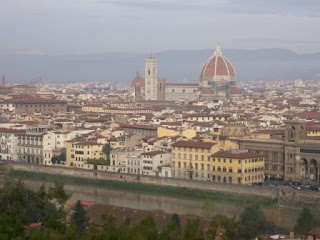
1. Piazzale Michelangelo. From this hillside you have splendid views overlooking the Arno, the Ponte Vecchio, the Duomo, and all the beautiful golden toned, red tile roofed architecture of Renaissance Florence. You may also view the expansive villas built by the nobles of Florence.
2. Galleria dell’ Accademia: Michelangelo’s David. This is the most beautiful and moving statue I have ever experienced. Michelangelo chose to carve David poised in expectation, focus and concentration immediately before David felled the giant Goliath with only a strap and five smooth stones. David fully trusted that God was on his side and that He would prevail.
3. Duomo. Each city’s largest church is called its Duomo or Cathedral. Florence architect Filippo Brunelleschi made it his life’s work to build the world’s largest dome to cover the cathedral. The work was completed after 16 years of construction in 1436. The Battistero or baptistery has three sets of bronze doors designed by Andrea Pisano and Ghiberti.
4. Galleria degli Uffizi. This museum contains superb Renaissance sculptures and paintings from the 15th Century to 17th and 18th century European artists including Rubens, Canaletto, Van Dyke, Caravaggio and Rembrandt. I was particularly amazed by the rich, pure colors of Doni Tondo (c1505) by Michelangelo, a circular portrayal of the Holy Family.
5. Piazza della Signoria. Florence’s most famous square contains the Neptune statue with bronze water nymphs adorning the fountain.
6. Ponte Vecchio. This 1593 bridge crowded with forty silver and gold jewelry shops is one of Florence’s most famous landmarks.
7. Piazza Santa Croce. The Franciscan Gothic church of Santa Croce contains the tombs of Michelangelo, philosopher Niccolo Machiavelli, composer Gioacchino Antonio Rossini, and scolar and humanist Leonardo Bruni. You may visit the monastery leatherworking school which provides students training to produce the fine leather goods renowned in Florence.
8. Santa Maria Novella. This church was established by Dominican friars in 1221 as a small chapel Santa Maria delle Vigne. Architect Leon Battista Alberti blended existing Gothic elements with new Renaissance features when he completed the intricate marble façade in 1458.
9. Museo Nazionale de Bargello. This fortress-like structure was built in 1255 as the government headquarters and later in 1865 became a National Museum of Italy.
10. Il Porcellino. The city emblem is a bronze statue of a wild boar. It is believed that if you rub the nose of the boar it will bring you good luck and ensure a return visit to Florence.



No comments:
Post a Comment